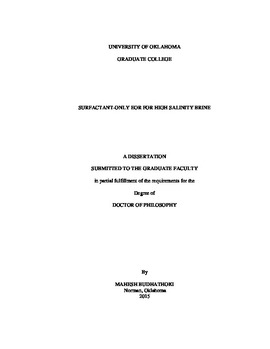| dc.contributor.advisor | Harwell, Jeffrey | |
| dc.contributor.author | Budhathoki, Mahesh | |
| dc.date.accessioned | 2015-08-13T17:33:32Z | |
| dc.date.available | 2015-08-13T17:33:32Z | |
| dc.date.issued | 2015 | |
| dc.identifier.uri | https://hdl.handle.net/11244/15503 | |
| dc.description.abstract | Developing a surfactant formulation for reservoir having high salinity/total dissolved solids (TDS) brine is a challenging task because surfactant not only phase separate or precipitate but also show high adsorption on reservoir rocks under such condition. These issues pose major threat on technological and economic viability of surfactant based chemical enhanced oil recovery (cEOR) technique. Therefore, this study attempts to overcome such challenges by investigating the feasibility of an alcohol free binary mixtures of sodium alkyl alkoxy sulfate surfactants and a sodium alkyl ethoxy sulfate surfactant for reservoir brine having a TDS of 301,710 mg/l with total hardness of 12,973 mg/l. The optimized surfactant formulations show excellent aqueous phase stability, produce an ultra-low-interfacial tension (IFT) of 0.004 mN/m, and give fast coalescence rates of less than 30 minutes at reservoir conditions. Accuracy of the hydrophilic lipophilic deviation (HLD) method in predicting the ratio between two surfactants to give optimal Type III microemulsion is also studied. Results show that correct determination of surfactant’s head constant, K, and temperature constant, αT, determines the accuracy of the HLD method.
This study also demonstrates the field feasibility of the proposed surfactant formulation. Sand pack studies are performed in laboratory in order to optimize surfactant-only slug for field test. Single well tracer tests (SWTTs) are conducted before and after surfactant injection to assess the oil mobilization efficiency of laboratory optimized formulation at the field. Numerical simulation method is further applied to interpret field data. The results show approximately 73% reduction of residual oil saturation (Sor) demonstrating the efficacy of lab optimized surfactant-only flood system in ultra-high TDS reservoir.
Furthermore, this work investigates the efficacy of polyelectrolyte, polystyrene sulfonate (PSS), as a sacrificial agent for lowering surfactant adsorption at reservoir conditions. Four different molecular weight PSSs are evaluated through equilibrium and dynamic adsorption studies carried out on Brea sandstone and Ottawa sand. Results show significant reduction in surfactant adsorption after PSSs addition. Moreover, the sand pack studies are conducted to evaluate the effect of PSS minimized surfactant adsorption on oil mobilization/recovery. Results indicate improved oil recovery in the presence of PSS suggesting its potential future as sacrificial agent in cEOR. | en_US |
| dc.language | en_US | en_US |
| dc.subject | Microemulsion | en_US |
| dc.subject | Enhanced Oil Recovery | en_US |
| dc.subject | Surfactant | en_US |
| dc.subject | Hydrophilic Lipophilic Deviation (HLD) | en_US |
| dc.subject | High Salinity | en_US |
| dc.subject | Surfactant Adsorption | en_US |
| dc.subject | Sacrificial Agent | en_US |
| dc.title | SURFACTANT-ONLY EOR FOR HIGH SALINITY BRINE | en_US |
| dc.contributor.committeeMember | Shiau, Bor-Jier (Ben) | |
| dc.contributor.committeeMember | Jamili, Ahmad | |
| dc.contributor.committeeMember | O' Rear III, Edgar | |
| dc.contributor.committeeMember | Lobban, Lance L. | |
| dc.date.manuscript | 2015 | |
| dc.thesis.degree | Ph.D. | en_US |
| ou.group | College of Engineering::School of Chemical, Biological and Materials Engineering | en_US |
